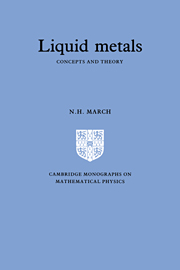Book contents
- Frontmatter
- Contents
- Preface
- 1 Outline
- 2 Pair correlation function and structure factor of ions
- 3 Thermodynamics
- 4 Electron screening and effective ion-ion interactions
- 5 Interionic forces and structural theories
- 6 Statistical mechanics of inhomogeneous systems and freezing theory
- 7 Electronic and atomic transport
- 8 Hydrodynamic limits of correlation functions and neutron scattering
- 9 Critical behaviour
- 10 Electron states, including critical region
- 11 Magnetism of normal and especially of expanded liquid metals
- 12 Liquid-vapour surface
- 13 Binary liquid-metal alloys
- 14 Two-component theory of pure liquid metals
- 15 Shock-wave studies
- 16 Liquid hydrogen plasmas and constitution of Jupiter
- Appendices
- References
- Index
6 - Statistical mechanics of inhomogeneous systems and freezing theory
Published online by Cambridge University Press: 19 January 2010
- Frontmatter
- Contents
- Preface
- 1 Outline
- 2 Pair correlation function and structure factor of ions
- 3 Thermodynamics
- 4 Electron screening and effective ion-ion interactions
- 5 Interionic forces and structural theories
- 6 Statistical mechanics of inhomogeneous systems and freezing theory
- 7 Electronic and atomic transport
- 8 Hydrodynamic limits of correlation functions and neutron scattering
- 9 Critical behaviour
- 10 Electron states, including critical region
- 11 Magnetism of normal and especially of expanded liquid metals
- 12 Liquid-vapour surface
- 13 Binary liquid-metal alloys
- 14 Two-component theory of pure liquid metals
- 15 Shock-wave studies
- 16 Liquid hydrogen plasmas and constitution of Jupiter
- Appendices
- References
- Index
Summary
In Chapter 5, the statistical mechanics of homogeneous bulk liquids was treated, mainly within a pair potential framework. The generalization of this theory will next be set up to deal with inhomogeneous systems. One important application will be to the study of the liquid-vapour interface, developed in Chapter 12. However, the immediate application will be to the theory of freezing of liquid metals.
Specifically, the focal point of this chapter is the idea that correlation functions in a bulk liquid near to its freezing point already contain valuable information pertaining to the properties of its solid near melting. An example that can be cited here is the theory of the liquid-solid transition due to Kirkwood and Monroe (1941). This theory was based on the so-called hierarchy of statistical mechanical equations for the various order distribution functions (see, for example, Hill, 1956), generalized to apply to inhomogeneous systems (e.g., a solid with a periodic rather than constant single-particle density). The Kirkwood-Monroe theory certainly requires as basic knowledge the pair potential φ(r) and the homogeneous pair function g(r) discussed at length in the preceding chapters.
Single-particle density related to direct correlation function
Lovett and Buff (1980) have revived interest in the question of whether classical statistical-mechanical equations, such as the first member of the Born-Green-Yvon hierarchy, which connects the singlet density ρ(r) and the liquid pair correlation function g(r) can admit more than one solution for ρ for a given g (see Kirkwood and Monroe, 1941). Actually, these workers focused on the equation relating ρ and the Ornstein-Zernike direct correlation function c(r) of a liquid.
- Type
- Chapter
- Information
- Liquid MetalsConcepts and Theory, pp. 43 - 61Publisher: Cambridge University PressPrint publication year: 1990



